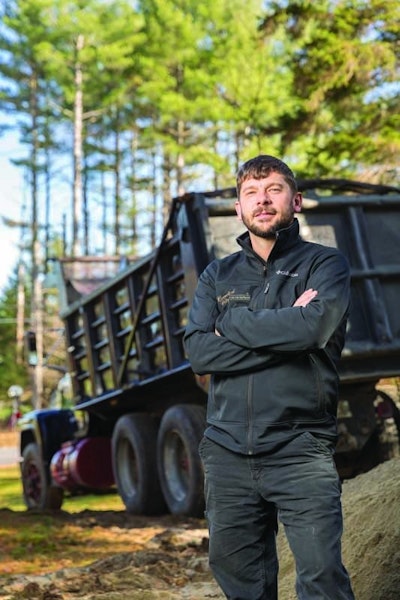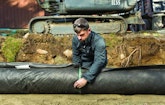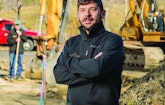
Interested in Systems/ATUs?
Get Systems/ATUs articles, news and videos right in your inbox! Sign up now.
Systems/ATUs + Get AlertsA career working for the state as a vocational rehabilitation counselor didn’t offer personal satisfaction for Mike Carbonneau of Littleton, New Hampshire. But subsequent employment in an uncle’s excavation business was another story. That job had ignited Carbonneau’s love of the outdoors, heavy equipment, and independence.
After taking engineering and wetland delineation classes at the University of New Hampshire, he received his septic installer’s license from the state Department of Environmental Services in 2004 and opened Connecticut Valley Septic Design in Littleton. A year later, at age 32, Carbonneau earned his septic designer’s license.
“I kept my nose to the grindstone and focused on survival for quite a while,” he says. “The transition from the government sector to self-employment was tough.” As the business stabilized, Carbonneau branched into presenting educational seminars and assisting clients requiring wetland and shoreland permits as part of onsite permits.
Carbonneau attributes his success to a college education and a willingness to accept technical advancements and try new things. “My solution-based approach saves customers money and generates more jobs,” he says. He also rarely advertises, relying on referrals from customers and Realtors to generate the majority of business.
GAINING A FOOTHOLD
The Littleton area has limited opportunities for employment and career paths. The main option is working as a contractor. Carbonneau chose the septic industry for its physical and environmental challenges. A friend taught him how to read soils and install systems, mostly mounds.
Carbonneau bought a Hitachi EX60 excavator, rented a bay from a friend with a large garage, and found basic excavation projects. As they increased in complexity, he sold the machine and upgraded to a Samsung SE130 LC-2 excavator. Today, his strategy is to buy used but well-kept equipment, then continue the good care.
“I also want everything super clean because I like to look professional when I show up,” says Carbonneau. “I take a lot of pride in doing my best in everything.”
Although being a designer and installer seemed like a foolproof business plan, it had unforeseen challenges. Local contractors no longer saw Carbonneau as the neighbor down the road.
“Even though I introduced myself as a septic designer, they feared I would steal their customers,” he says. Over the years, Carbonneau has solidified his reputation for maintaining professional boundaries, and now five contractors hire him to design systems.
COLD CALLING
Still looking to build a customer base, Carbonneau heard about Realtors who had lost sales because they didn’t have a septic permit, they didn’t understand a system evaluation, or they overlooked details needed for permit applications. “The state returned permits because they were missing a registry book and page for deeds, a tax map and lot number, or a copy of a tax map,” says Carbonneau.
One winter, he developed a PowerPoint presentation on what had to be submitted with septic designs to expedite permits. To market the program, Carbonneau walked into real estate offices within 50 miles and delivered his sales pitch. “Many took me up on it because they love to bring new things to staff meetings,” he says.
As Carbonneau learned more about what information Realtors needed, he developed a second presentation on 10 septic systems common to the area. In layman’s terms, he explained components and how they worked. “Once they understood the vocabulary, septic designs no longer scared them,” he says.
With encouragement from Realtors, Carbonneau expanded the programs into courses approved by New Hampshire and Vermont for continuing education credits. When the New Hampshire Shoreland Water Quality Protection Act and the Vermont Shoreland Protection Act became effective in 2014, he developed a training session on how they affected real estate and septic designs.
Teaching helps Carbonneau diversify productively. “Anybody can buy a pickup truck, a plow, and push snow around,” he says. “Higher education developed my writing and organizational skills, enabling me to focus on training programs and designing systems – areas with scant competition.”
UPSIZING THE BUSINESS
Like many northern contractors, Carbonneau’s brief work season lasts from May through the end of November. In 2015, the state lifted the heavy-equipment road ban on May 16. Late out of the gate and with a packed service board, Carbonneau lost some basic jobs because customers believed he didn’t respond fast enough.
“During the last two to three years, I’ve worked with more contractors and had more return customers,” he says. “The problem is I risk offending clients if they have to wait too long.”
Part of the solution is adding more permanent staff. Currently, Carbonneau has one full-time employee, his nephew Pat Cullen. Justin Marvin joins them in summer, as does Perry Williams, a retired land surveyor who works 10 hours a week helping design systems. They produce 50 to 60 designs per year.
Over the last two years, Carbonneau prepared for expansion by buying more equipment. In late fall 2015, he built a 3,200-square-foot garage with a yard on 7 acres to store the Samsung excavator, a Volvo EC55B compact excavator, a Caterpillar 257B tracked skid-steer loader and 416C IT backhoe, a D-3 Caterpillar bulldozer, and two dump trucks he built with Bibeau boxes, a Mack 10-wheeler and a Chevy 1-ton pickup truck. The shop, with an office, two bays, wash stall, and a car lift, provides the opportunity to hire a full-time employee and keep more staff busy in winter maintaining or repairing other contractors’ equipment.
WET AND WILD
The company generates 85 percent of residential revenue from a 50/50 split between 20 new installations and replacements per year. Commercial installations comprise 15 percent of revenue. Many replacement systems are delicate waterfront projects requiring septic, shoreland and wetland permits.
“Contractors shy away from them because they don’t like dealing with so many regulatory officials,” says Carbonneau. “For someone like me who develops permits all day, this was opportunity knocking.”
The shoreland acts require developers to draw special permits if they are within a 250-foot buffer zone from the high water mark to the water. Special permits, however, also require historical data searches and mapping of endangered species and American Indian burial grounds, listed on state databases and archives.
Carbonneau must delineate wetlands 75 feet from septic systems in New Hampshire and 50 feet in Vermont. “If I had to hire a soil or wetland scientist to map wetlands for my septic designs, I’d wait 90 days or longer,” he says. “My ability to expedite all three permits for clients is a niche that protects
my livelihood.”
REVERSE ENGINEERING
Replacement designs are the most challenging for Carbonneau because of setbacks, permanent structures, pumping schedules for occupied homes, and rain, which stops all work because much of it is on steep slopes. A recent project involved replacing a pipe-and-stone leachfield built level on a backfilled 20 percent grade. “The system began progressive failure from day one as the backfill settled,” says Carbonneau.
The field was below the three-bedroom home and 10 feet below the area where the dump truck delivered sand and components. “Such sites require planning each step because there is no going back down,” says Carbonneau. He began by excavating to the original grade, then backed up to prepare a terraced basal surface area. On subsequent moves back, Carbonneau cut a shelf with the excavator to create a level work surface.
After he made a small, flat ramp for foot traffic, the crew prepared the ASTM C-33 concrete sand beds for the passive Advanced Enviro-Septic (AES) drainfield from Presby Environmental. Because it is accredited as an aerobic treatment system, New Hampshire allows a 60 percent reduction in footprint over pipe-and-stone drainfields, and Vermont allows a 50 percent reduction.
“Typically, the basal area for similar stone-and-pipe fields is 675 square feet,” says Carbonneau. “It’s only 270 square feet for an AES system, which is why they work well for replacements in our landscape and hilly terrain.”
For each row of combined treatment and dispersal pipes, the crew drove grade sticks every 5 feet in a straight line. After preparing the sand with a rake and ensuring it was firmly packed, they laid the pipes against the stakes, which prevented them from rolling downhill. When the field was backfilled, the stakes also held the pipes at the required elevation and distance between laterals.
“We saved the customer a ton of money over building a giant, flat mound against the hill,” says Carbonneau. “The terraced field also blended into the topography better than a mound.”
ON THE HORIZON
While satisfying clients is a tremendous accomplishment, Carbonneau is proudest of making it in business and retaining employees.
“Quitting a good state job took a big leap of faith,” he says. “Now I’m ready to expand the company and add more employees. However, it’s important that what they do is an extension of the quality I expect. Finding those people will be difficult, so I’ll advance at my own pace.”
Tools for efficiency
Keeping workers and equipment off backfilled leachfields during final finishing was always a challenge for Connecticut Valley Septic Design, until owner Mike Carbonneau observed other contractors using a homemade grading beam. So he made one from a 7-foot length of scrap Schedule 80 steel pipe. He marked the middle of the 8-inch pipe, then cut 2- by 3-foot-wide horizontal slits on either side, inserted a 3/4-inch-thick plate, and welded it in place. The apparatus weighs 250 to 300 pounds.
“We use the Samsung excavator to grab the plate with the bucket and thumb, then grade the loam for a smooth finish,” says Carbonneau. “It’s quick and we’re not treading over the receiving area.”
Another tool Carbonneau uses to make excavation easier is the Leica Geosystems Total Station, a theodolite with a unique in-the-field ability. After loading the septic design plan into the unit’s gun, Carbonneau can stake out the precise corner locations for the structure and leachfield without tangling reel tapes in bushes or trying to measure through buildings. The station works with a Carlson MINI2 data collector.
Working in mountains means excavators frequently encounter ledges. Carbonneau has taken the guesswork out of digging by researching county websites for the locations of the best soils and house sites. “It’s common to dig 8 feet, move 20 feet, and hit a ledge at 6 inches,” he says. “Several times we’ve had to blast to set a tank. I learned to add a clause to bids that if we hit ledge or large rocks, it becomes a time and material project.”










